- Home
- David McCullough
The Great Bridge Page 20
The Great Bridge Read online
Page 20
The caissons were the foundations of the great work, quite literally and figuratively, as everyone working with Roebling in Brooklyn was aware. There were also some among them who appreciated something that would be overlooked by most everyone as time passed—that it was Washington Roebling, more than his father, who was the closest thing to an expert on caissons and who had concentrated on how that part of the job ought to be handled. And perhaps this helped compensate some for the very obvious fact that he had never actually worked with a caisson before and that there were only two or three American engineers who had, McAlpine being one of them. In St. Louis Captain James B. Eads had just completed the first caisson for his bridge over the Mississippi. Still, to all but a handful of engineers, even the word “caisson” was unfamiliar.
With absolute, unqualified conviction John A. Roebling had proclaimed that his bridge would be the greatest in existence, the greatest engineering work of the age. All his son had to do now was build it.
PART TWO
8
All According to Plan
The foundations for the support of these large masses of masonry must be unyielding.
—JOHN A. ROBELING
THE EASIEST way to explain how the caisson would work, Roebling and his assistants found, was to describe it as a huge diving bell that would be built of wood and iron, shaped like a gigantic box, with a heavy roof, strong sides, and no bottom. Filled with compressed air, it would be sent to the bottom of the river by building up layers of stone on its roof. The compressed air would keep the river out, help support the box against the pressure of water and mud, and make it possible for men to go down inside to dig out the riverbed. As they progressed and as more stone was added, the box would sink slowly, steadily, deeper and deeper, until it hit a firm footing. Then the excavation could stop, the interior of the box would be filled in solid with concrete, and that would be the foundation for the bridge tower.
The idea was quite simple really. Furthermore, it had been used successfully in Europe for more than a generation, first in France, where the word “caisson,” meaning “chest,” had originated, then later in England and Germany. An air lock that enabled workers to get in and out of a sealed chamber filled with compressed air had been devised as early as 1831 by Lord Thomas Cochrane, the controversial British admiral, and in 1851 a pneumatic caisson had been used on a bridge foundation for the first time, for piers in the Medway River at Rochester, England. Seven years after that Brunel had taken a caisson down more than seventy feet to build a pier for his last and greatest railroad bridge, the Royal Albert over the Tamar at Saltash, Cornwall.
But the caisson Roebling intended to sink beneath the East River on the Brooklyn side would be bigger by far than anything used in Europe or the few that had been used in the United States, and the one for the New York tower, it was then thought, would have to go thirty to forty feet deeper than even Brunel had gone.
The caisson the Roeblings had designed, and which in the late fall of 1869 began slowly to take shape at the Webb & Bell yards, was to be built like a fort and launched like a ship. A gigantic rectangular box, 168 feet long and 102 feet wide, it was to have nine and a half feet of headroom inside and overhead a roof of solid timbers five feet thick, bringing the total height of the box to fourteen and a half feet. In area it would be more than half the size of a city block, more than half the size of the new St. Patrick’s Cathedral, for example. The sides of the box were to be V-shaped, being nine feet thick where they joined the roof and tapering to a bottom cutting edge of just eight inches. The inside slope of the V would be at an angle of about forty-five degrees and the entire cutting edge, or “shoe,” would be shod with a heavy iron casting and sheathed the whole way around with boiler plate extending up three feet, inside and out. A heavy oak sill two feet square would rest on the casting.
Driftbolts, screw bolts, and wood-screw bolts would be used to secure the whole immense mass. The V-shaped sides would be fixed to the roof with heavy angle irons. At the corners, timber courses would be halved into each other and strapped together. The roof itself would be built of five solid courses of yellow pine “sticks”—timbers a foot square—laid up side by side and bolted both sideways and vertically.
To make the box airtight the seams would be caulked with oakum to a depth of six inches, inside and out, and between the fourth and fifth courses of roof timber, across the entire top of the structure and extending down all four sides, a vast sheet of tin would be put down. The tin on the outside would be further protected by a sheathing of yellow pine and the spaces between timbers would be filled with hot pitch.
Since Roebling had learned that air under pressure of forty or fifty pounds (or about what would be needed inside the work chamber) will readily penetrate ordinary wood, he had selected a yellow pine from Georgia and Florida that was so pitchy that the 12-by-12 sticks would not even float. And finally, just to be sure, he planned to coat the whole inside with a specially concocted, supposedly airtight varnish.
Once the caisson was launched, ten additional courses of timber would be added to the roof, thereby making it a solid timber platform fifteen feet thick, which would act like a colossal wooden beam for carrying and distributing the load of the tower.
As the work at Webb & Bell progressed on the raw and ungainlylooking structure, two air locks, two so-called supply shafts, and two water shafts were being built into the timber roof.
The air locks were made of half-inch boiler plate. They were cylindrical in shape, seven feet high by six and a half feet in diameter, or big enough to pack in about a dozen men, who would enter from the top, through an iron hatch about the size of a manhole cover. The hatch closed, an attendant stationed inside would open a valve near his feet, releasing compressed air from the work chamber below into the lock. As soon as a gauge on the wall of the lock showed the pressure there equal to that below, another hatch in the floor would be opened and the men, one by one, would climb down a ladder through an iron shaft, three a half feet in diameter, into the caisson itself.
When it was time to come out, the process would be reversed. They would climb up the shaft and into the air lock, the floor hatch would be secured, and another valve would be opened to release the air from the lock. When pressure in the lock decreased to normal atmospheric pressure, or 14.7 pounds per square inch, then the top hatch would be opened and the men would climb out. This way the loss of compressed air from the caisson each time a gang of men went in or out was no more than the volume of the lock.
The water shafts were a very simple but ingenious means by which the mud and rock excavated inside the work chamber could be hauled out with no loss of compressed air whatsoever, and with none of the time required to move through an air lock.
The water shafts were seven feet square, open at top and bottom, and they extended like twin wells through the roof of the caisson straight down into the work chamber to a depth nearly two feet below that of the caisson’s bottom edge. These shafts were also built of boiler plate and once the caisson was in operation they would be filled with water to a level sufficient to “lock in” the compressed air below.
At the base of the shafts, at the two points where they extended deeper than the caisson itself, open pits would be dug in the river bottom, which would also fill with water. These would be the delivery ends of the shafts and the columns of water within the shafts would be kept suspended (kept from flooding in on the workers) by the pressure of the air within the chamber.
The water shafts, as one magazine of the time explained for its readers, were essentially huge barometers that measured the pressure of the air inside the caisson. The shaft itself was the barometer tube, filled with water instead of mercury, and the pool at the bottom was the cistern. Every pound of pressure in the caisson above normal atmospheric pressure (which of course was bearing down on top of the column of water) forced the water a little more than two feet higher in the shaft.
To get rid of the material they excavated, the
men would shovel it into the pits, or pools, at the base of the shafts, where it would be hauled up and out by big clamshell dredge buckets dropped down from above, directly through the shafts of water. The theory was the buckets could work as fast as the men could feed them. It was a neat, efficient system, so long as the water in the shafts stayed at the proper level. But if the volume of water in one shaft became too great—too heavy, that is, for the compressed air below to support it—then the water in the pit would flood out into the work area. Or, if for some reason, the volume of water decreased to the point where its weight was no longer enough to counteract the pressure in the chamber, then there would be a terrific release of air, or blowout, from below.
The supply shafts were only twenty-one inches in diameter and simply the means by which Roebling intended to get the necessary cement, sand, and gravel into the caisson once the excavation was finished.
John Roebling’s thought had been to make the interior of the caisson one big open space, with no divisions or supports to get in the way of the excavation work. But his son had to abandon that idea for several reasons. First of all, since the caisson would have to be launched like a ship—only in this case a ship built upside down—there would have to be supports of some kind between the launchways and the roof. Washington Roebling also anticipated that the cutting edge of the caisson would be striking on boulders on its way into the riverbed and when that happened he did not want the entire weight resting solely on those few points. But it was chiefly because of the particular nature of the East River that he decided to divide up the work chamber with a number of supporting walls.
The East River connects the Upper Bay of New York with Long Island Sound, and because it has two entrances—at the tip of Manhattan and at Hell Gate, the opening to Long Island Sound—and two distinct tidal movements arriving at these points at different times of the day, its currents are quite unlike those of any ordinary river. The water is full of whirlpools and eddies caused by a bottom of jagged peaks and huge potholes, some as much as fifty feet deep. And with the tides surging in and out of the narrow openings, the currents are swift, turbulent, and something very serious to contend with. Even with a favorable wind the great sailing ships of the day could make little headway against an outgoing East River tide and would often stand in considerable numbers in the bay, like small armadas, waiting for the tide to change.
“The extreme rise and fall,” Roebling explained, “is seven and a half feet. If the inflated caisson is just barely touching the ground at high water, it will press upon the base with a force of 4,000 tons at low tide, all of which has to be met by the strength of the shoe and the frames.” Not until the caisson was permanently “righted down” under several hundred tons of tower stone would this powerful, potentially destructive up-and-down action stop.
So he had Webb & Bell build in heavy truss frames of pine posts and stringers, with three-inch sheathing on each side and side braces to the roof every six feet. There were five of these inside partitions, each running the width of the caisson and dividing the interior into six separate chambers, each 28 by 102 feet. Once the caisson was in the water and resting on the bottom, doors would be cut in the partitions so the men could go back and forth from one chamber to another.
As the mammoth timber box grew on the ways, it looked like nothing ever seen before in an East River yard. Seven launchways were required (one for each of the outer edges, five under the interior partitions), and the total weight of the structure, by the time it was ready for launching, would be six million pounds, or three thousand tons, which was, for example, a thousand tons more than the Challenge, leviathan of the clipper ships built in East River yards. The caisson would contain some 110,000 cubic feet of timber and 230 tons of iron and it was being built to go down the ways in the usual fashion of a great ship, its long side toward the water. For the time being it stood fifty feet back from the ends of the ways, and as everyone who had had any experience with shipbuilding knew, the great danger of launching so large a mass was the chance that one end might get going faster than the other and the whole gigantic affair would wedge tight on the ways. It was also necessary of course that the caisson get up enough momentum coming down the ways to overcome the immense resistance offered by the water. So just getting the thing launched was an engineering problem of very major proportions. Indeed, Roebling said later that the problems of launching the caisson and of protecting it against sea worms caused him more anxiety than the prospect of sinking it.
As might be expected, all such questions and the steady progress of construction were of enormous interest to innumerable bystanders. Day after day people came down to the yards at the foot of Noble Street to take a look for themselves, even after the first snows arrived. Newspapermen and some of Tweed’s people came over from New York, as well as a number of engineers, not the least of whom was Captain Eads from St. Louis, whose own caisson was being sunk beneath the Mississippi by this time and who happened to be in New York on some other matter.
So concerned were the Webb & Bell people over the problems involved, so different was this job from any they had ever handled in all their previous experience, that they had insisted on being paid in advance—$100,274.51.
Once the caisson was in the water, the plan was to tow it downriver. How seaworthy it would prove to be in the turbulent current was another open question. After giving the caisson a thorough inspection, James B. Eads told Roebling he could expect trouble and said it might topple over if he inflated it during the trip downstream, which was exactly Roebling’s intention.
In the meantime, however, the waterfront had to be cleared at the point where the caisson would be docked and the riverbed had to be dredged deep enough for the huge structure to be floated into place. The clearing of the site began on Monday, January 3, 1870, and because the winter turned out to be abnormally mild, the work there, like the work at the shipyard, moved along faster than expected. Any other winter it would have been impossible to do much of anything.
Clearing the site took about a month. For daily commuters on the Fulton Ferry it all provided an interesting show and the first real sign they had had that the bridge was actually under way. About half of one big ferry pier had to be dismantled, fender sheathing torn out, massive stone-filled cribbing removed, and all without disrupting ferry service. An enormous steam crane, called the “Ox,” was brought in on a barge to pull out the old piles, and as they came up one after another, there was much amazement over the toll the East River had exacted. Each one was infested with thousands of sea worms in the area between the low-water mark and the mud line. As Roebling noted, “A pile which was sixteen inches in diameter below the mud, perfectly sound and free from worms, would be found eaten away to a thin stem of three inches just above the mud, and all timber was affected alike.” Then so that no one missed the point, he added, “This shows the necessity of going below the top of the riverbed with our timber foundation, and also proves its entire safety in that position.”
Once the old dockwork was out of the way, a large basin was to be built to contain the caisson, open toward the river but bounded on three sides with new piling. Within this area the riverbed was to be dredged to a uniform depth of eighteen feet at high tide, or deep enough to keep the caisson afloat at all stages of the tide. The dredges made great headway at first, as long as there was only surface mud to contend with, but then they hit hardpan and boulders. “The character of this material was next to solid rock,” Roebling wrote. The dredges could make but the slightest impression upon it. “Recourse was necessarily had to powder,” and the blasting commenced at night, from about seven in the evening until daylight, when traffic was light on the river and few people were about the ferry slip. Holes were driven into the river bottom with steel-headed iron piles. Then blasting charges were packed into iron canisters and dropped into the holes by professional divers. When the divers were out of the way and the pile drivers hauled back to a safe distance, the charges were set off by electric
ity.
Three pile drivers were kept in action, and with a little practice the men had the work down to a neat system, setting off some thirty-five blasts every ten-hour shift. During the day the dredges moved in and cleared out the results of the night’s work.
A number of the boulders encountered were too large to be picked up by a dredge and had to be dragged clear—the divers assisting underwater. The whole process was about six times as expensive as normal dredging, but still quite effective, and it provided valuable knowledge of the ground the caisson would have to penetrate. On one side, for example, near the new piling, a dozen blows of the pile driver would sink an iron pile forty feet through soft clay, but in the center area it took a hundred blows to go three feet. Toward the ferry the clay gave way to boulders of all sizes, closely packed, with coarse sand in between, and at the open end of the basin, on the river side, all soft strata had been washed away, leaving hardpan.
As time passed, Roebling decided to concentrate the dredging along the lines of the caisson’s edges and frames; the parts in between could be removed later, he said, from inside the caisson. He also had two holes blasted to an extra depth to accommodate the water shafts.
The work went slowly now, and while the blasting and dredging provided valuable knowledge of the riverbed, that knowledge itself was a most sobering reminder of the magnitude of what they were undertaking. To sink a wooden box as big as a fair-sized railroad station straight down through such material, and underwater, keeping the thing absolutely level the whole time, and bringing it to rest finally—perhaps fifty feet down—and at the exact spot it was meant to be, was a very tall order indeed. And added to that, along toward the end of January, reports began coming in from St. Louis of a strange malady among the men working inside the Eads caisson.

 John Adams
John Adams The Greater Journey: Americans in Paris
The Greater Journey: Americans in Paris 1776
1776 Truman
Truman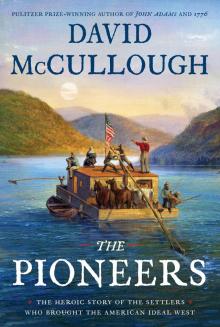 The Pioneers
The Pioneers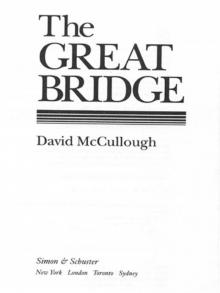 The Great Bridge: The Epic Story of the Building of the Brooklyn Bridge
The Great Bridge: The Epic Story of the Building of the Brooklyn Bridge The American Spirit
The American Spirit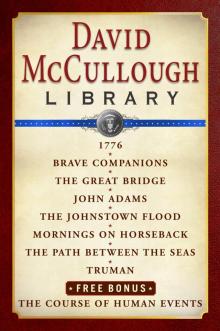 David McCullough Library E-book Box Set
David McCullough Library E-book Box Set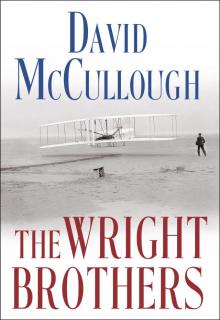 The Wright Brothers
The Wright Brothers The Greater Journey
The Greater Journey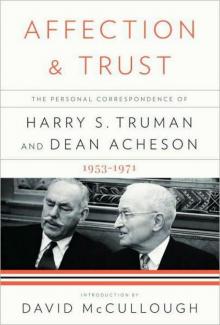 Affection and Trust: The Personal Correspondence of Harry S. Truman and Dean Acheson, 1953-1971
Affection and Trust: The Personal Correspondence of Harry S. Truman and Dean Acheson, 1953-1971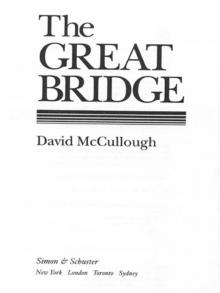 The Great Bridge
The Great Bridge